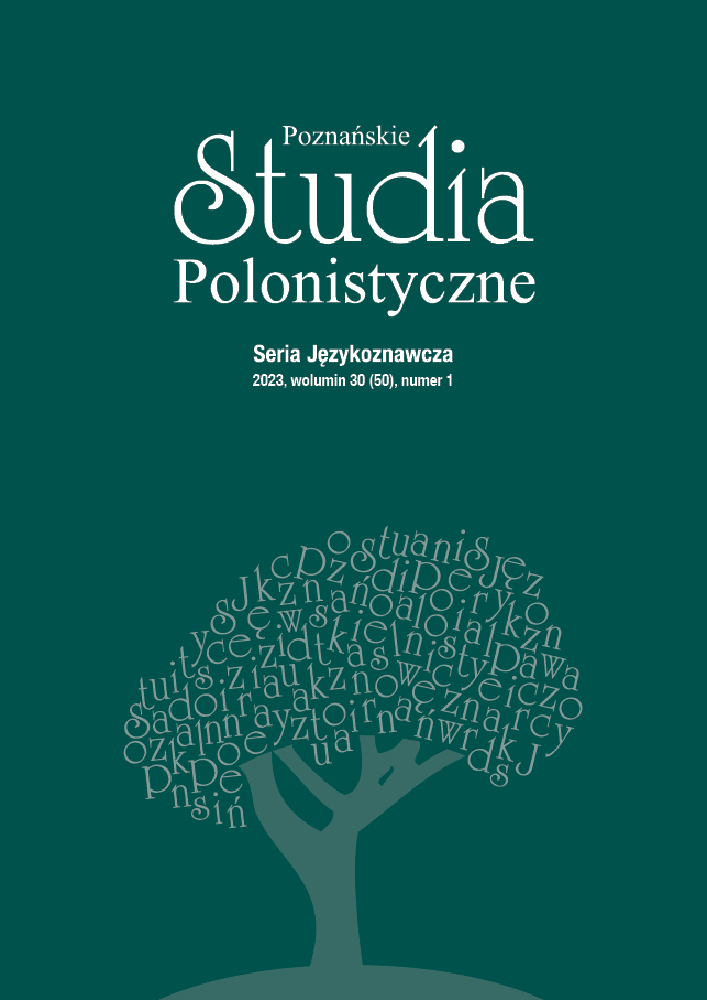Abstract
The aim of the article is to present an overview of the semantic analyses of threat understood as a speech act that have been so far conducted in Polish linguistic studies. The overview includes three selected analyses. The first one is based on the idea of necessary and sufficient conditions proposed by Anna Wierzbicka. The second is Joanna Wołoszyn’s work based on a methodology developed in line with structural semantics and attempts to define the terms straszyć (to scare) and grozić (to threaten). The third one is an analysis by Roman Kalisz and Wojciech Kubiński based on prototypical effects in speech acts, meaning that it relies on the methodology of cognitive linguistics. The overview is complemented by a critical analysis focused on identifying the imperfections of all three ideas presented in it and by a presentation of possible and legitimate improvements.
References
Austin John Langshaw (1993), Jak działać słowami, w: tenże, Mówienie i poznawanie. Rozprawy i wykłady filozoficzne, przeł. Bohdan Chwedeńczuk, Warszawa.
Bierwiaczonek Bogusław (2000), Religijne subkategorie miłości, „Język a Kultura”, t. 14, s. 79–115.
Falana-Jafra Anna (2021a), Pojęcie przestępstwa lingwistycznego i jego typologie, „Poznańskie Studia Polonistyczne. Seria Językoznawcza”, nr 1, s. 45–56. DOI: https://doi.org/10.14746/pspsj.2021.28.1.3
Falana-Jafra Anna (2021b), Przestępstwa językowe jako przedmiot etnolingwistycznych badań porównawczych, „Etnolingwistyka. Problemy Kultury i Języka”, nr 33, s. 205– 218. DOI: https://doi.org/10.17951/et.2021.33.205
Grochowski Maciej (1982), Zarys leksykologii i leksykografii. Zagadnienia synchroniczne, Toruń.
Grochowski Maciej (1989), O pojęciu groźby, „Polonica”, nr 14, s. 33−44.
Kalisz Ryszard, Kubiński Wojciech (1993), Speech Act as a Radial Category, w: Images from the Cognitive Scene, red. Elżbieta Górska, Kraków.
Kleiber Georges (2003), Semantyka prototypu. Kategorie i znaczenia leksykalne, przeł. Bronisława Ligara, Kraków.
Michalska-Warias Aneta (2016), Groźba bezprawna jako ustawowe znamię przestępstwa zgwałcenia, „Ius Novum”, nr 1, s. 7–24.
Tabakowska Elżbieta, red. (1998), Kognitywne podstawy języka i językoznawstwa, Kraków.
Taylor John R. (2003), Linguistic Categorizations, Oxford.
Ustawa z dnia 6 czerwca 1997 r. – Kodeks karny, Dz.U. Nr 88, poz. 553 z późn. zm.
Wierzbicka Anna (1987), English Speech Act Verbs, Sydney.
Wierzbicka Anna (2006), Semantyka. Jednostki elementarne i uniwersalne, Lublin.
Wołoszyn Joanna (2016), Co znaczy straszyć? Próba analizy semantycznej, „Prace Językoznawcze”, nr 4, s. 173–186.
License
Copyright (c) 2023 Anna Falana-Jafra

This work is licensed under a Creative Commons Attribution-NoDerivatives 4.0 International License.
Authors
The Author declares that they are entitled to personal and property (material) copyrights to their work published in “Poznańskie Studia Polonistyczne. Seria Językoznawcza”, and that these rights are not limited by the terms of Author’s agreement. The Author warrants the originality, authorship, and sole ownership of all rights to the Work, and affirms that they have the right to grant all kinds of licenses hereinabove without infringing on the intellectual property rights of any third party, including personal rights.
The Author(s) retains copyright to their article and the right to freely dispose of the work, granting Adam Mickiewicz University in Poznań a non-exclusive, royalty-free licence under the Attribution-NoDerivatives 4.0 International (CC BY-ND 4.0) Creative Commons licence to use the Work without territorial restrictions for an indefinite period in the fields of use designated in the Author’s agreement.
Users
Interested Internet users are entitled to use works published in „Poznańskie Studia Polonistyczne. Seria Językoznawcza” since 2016 under the following conditions:
- attribution - obligation to provide, together with the distributed work, information about the authorship, title, source (link to the original work, DOI) and the license itself.
- no derivatives - the work must be preserved in its original form, without the author's consent it is not possible to distribute the modified work, such as translations, publications, etc.
Copyrights are reserved for all texts published before 2016.
Other
Adam Mickiewicz University in Poznań retains the right to the journal as a whole (including its layout, graphic design, title, cover design, logo and more).

